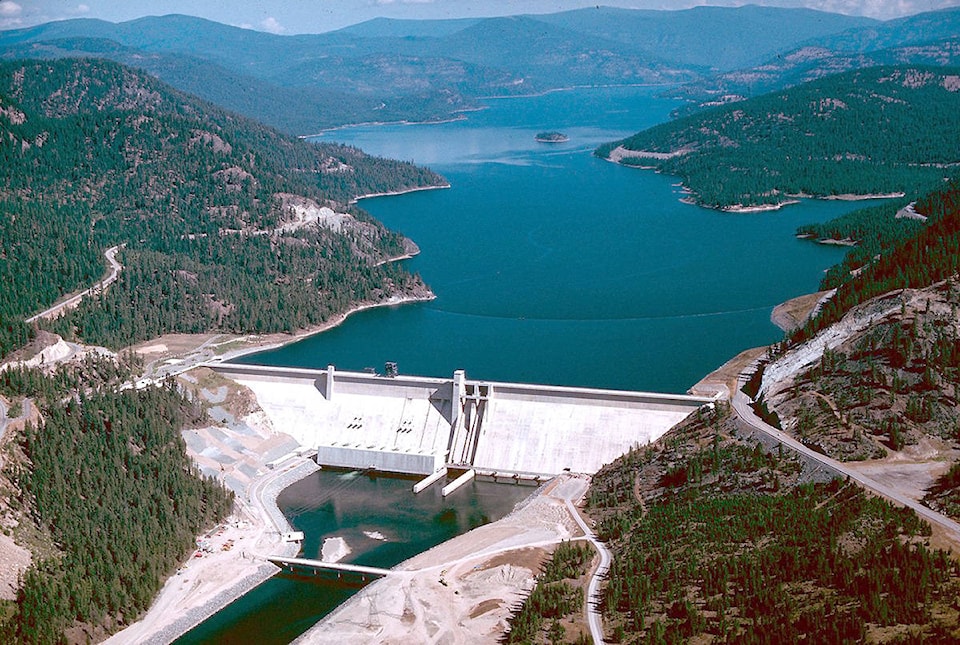Officials are predicting lower water levels at Lake Koocanusa this summer, with an expected peak approximately 10 feet below full pool in August.
Steve Barton, with the U.S. Army Corps of Engineers, which operates the Libby Dam in Montana on the American side of the Koocanusa Reservoir, says the reservoir is expected to peak at an elevation between 2,448 feet and 2,452 feet in early August.
Last year, the reservoir peaked at 2,451 feet on Aug. 9.
“So currently, we are at full powerhouse releasing the sturgeon flows for downstream and we expect that to through about… [May 29] at which point we will be ramping down to bull trout minimum and allowing the reservoir to fill throughout the early summer,” said Barton.
Operations at Libby Dam and other operations on the American side of the Columbia River were adjusted following the completion of the Columbia River System Operations Environmental Impact Statement, which updated environmental priorities and objectives through a five-year process that concluded last fall.
In the context of Lake Koocanusa, the updated ‘Record of Decision’ means adjustments to the Libby Dam operations, according to Barton.
“Many of those tie Libby’s operations more closely to the local water supply conditions while still contributing to it’s role in overall system operations,” Barton said. “But it allows for more flexible use of the water resource meeting multi-purpose objectives and an overall refinement of the process.”
The U.S. Army Corps of Engineers is forecasting an 88 percent of average water supply, with approximately 5.119 million acre-feet inflow expected between April and August at Libby Dam.
With the release of a sturgeon ‘pulse’ or increased outflows at the Libby Dam, biologists are hoping the conditions will encourage natural sturgeon spawning in the Kootenay River, particularly in areas near Bonner’s Ferry. Higher river flows act as a cue for sturgeon to move upstream and increases the likelihood of spawning.
“This year, a proportion of the sturgeon volume was released on May 6 and now we’re in the full powerhouse capacity coming out of Libby for the sturgeon pulse,” said Ryan Bart, fish biologist, U.S. Fish and Wildlife Service.
White Sturgeon in the Columbia Basin are listed as an endangered species under both Canadian and U.S. legislation.
Last year, 43 tagged adult sturgeon were detected above river-kilometre 230, just north of Bonner’s Ferry. Additionally, the first mature hatchery sturgeon male was captured, and eggs were observed at three sites in June.
This year, as part of the sturgeon flow, a floodplain will be inundated at Nimz Ranch in Idaho, which will provide more fish habitat that will benefit additional species beyond white sturgeon, according to Bart.
Management of water levels on Lake Koocanusa are traditionally a topic of local contention but the issue is included in the renegotiation of the Columbia River Treaty, a flood control management and power generation agreement ratified between Canada and the United States in 1964.
The terms of the treaty led to the construction of three dams on the Canadian side and one in the United States.
Operationally, BC Hydro officials have weekly contact with the U.S. Army Corps of Engineers and the Bonnville Power Administration to discuss operations throughout the treaty jurisdiction, according to Darren Sherbot, Manager, Operations Planning with BC Hydro.
Decisions made at Libby Dam operations can reverberate throughout other areas of the Columbia Basin river systems, he said.
“These discussions include near-term and longer term forecasts and planning,” said Sherbot, in a statement. “During particularly challenging situations, such as flood risk management on Kootenay Lake, downstream of Libby Dam, we have met up to twice a day to coordinate options for operations.”
On the Canadian side of the border, BC Hydro officials are forecasting a low water supply for the Kootenay system. Particularly for Kootenay Lake, Paul Cheng,Senior Engineer, BC Hydro, says Kootenay Lake is expected to reach 1,748 feet, due to a smaller spring runoff peak this year.
It was a challenging year due to COVID-19, which affected operations in a number of different ways, according to BC Hdyro.
The pandemic caused a reduction in power usage across the system, according to Sherbot. Combined with an above-average water supply, Arrow and Kinbasket reservoirs were full in the summer, which resulted in controlled spills.
Further challenges included delivering ongoing maintenance or completing capital projects in the context of creating and working through COVID-19 protocols.
“Work outages often affect generation and water management,” Sherbot said. “Subsequently, this too required additional planning and coordination to ensure sufficient energy supply across the winter and spring and effective reservoir management and river discharges for the spring of 2020.”
CORRECTION: An earlier version of this story contained an incorrect figure in the Koocansua reservoir’s summer forecast. In fact, Lake Koocanusa water levels are expected to peak between elevation 2,448 feet and 2,452 feet in early August. The Cranbrook Townsman apologies for the error.
